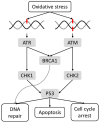Cancer and Aging: Two Tightly Interconnected Biological Processes
- PMID: 33808654
- PMCID: PMC8003441
- DOI: 10.3390/cancers13061400
Cancer and Aging: Two Tightly Interconnected Biological Processes
Abstract
Age is one of the main risk factors of cancer; several biological changes linked with the aging process can explain this. As our population is progressively aging, the proportion of older patients with cancer is increasing significantly. Due to the heterogeneity of general health and functional status amongst older persons, treatment of cancer is a major challenge in this vulnerable population. Older patients often experience more side effects of anticancer treatments. Over-treatment should be avoided to ensure an optimal quality of life. On the other hand, under-treatment due to fear of toxicity is a frequent problem and can lead to an increased risk of relapse and worse survival. There is a delicate balance between benefits of therapy and risk of toxicity. Robust biomarkers that reflect the body's biological age may aid in outlining optimal individual treatment regimens for older patients with cancer. In particular, the impact of age on systemic immunity and the tumor immune infiltrate should be considered, given the expanding role of immunotherapy in cancer treatment. In this review, we summarize current knowledge concerning the mechanistic connections between aging and cancer, as well as aging biomarkers that could be helpful in the field of geriatric oncology.
Keywords: aging; biomarkers; cancer.
Conflict of interest statement
The authors declare no conflict of interest.
Figures






References
Publication types
LinkOut - more resources
Full Text Sources
Other Literature Sources
Research Materials

